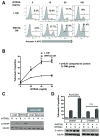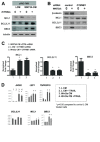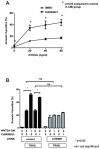Activation of Wnt/β-catenin signaling increases apoptosis in melanoma cells treated with trail
- PMID: 23869245
- PMCID: PMC3711908
- DOI: 10.1371/journal.pone.0069593
Activation of Wnt/β-catenin signaling increases apoptosis in melanoma cells treated with trail
Abstract
While the TRAIL pathway represents a promising therapeutic target in melanoma, resistance to TRAIL-mediated apoptosis remains a barrier to its successful adoption. Since the Wnt/β-catenin pathway has been implicated in facilitating melanoma cell apoptosis, we investigated the effect of Wnt/β-catenin signaling on regulating the responses of melanoma cells to TRAIL. Co-treatment of melanoma cell lines with WNT3A-conditioned media and recombinant TRAIL significantly enhanced apoptosis compared to treatment with TRAIL alone. This apoptosis correlates with increased abundance of the pro-apoptotic proteins BCL2L11 and BBC3, and with decreased abundance of the anti-apoptotic regulator Mcl1. We then confirmed the involvement of the Wnt/β-catenin signaling pathway by demonstrating that siRNA-mediated knockdown of an intracellular β-catenin antagonist, AXIN1, or treating cells with an inhibitor of GSK-3 also enhanced melanoma cell sensitivity to TRAIL. These studies describe a novel regulation of TRAIL sensitivity in melanoma by Wnt/β-catenin signaling, and suggest that strategies to enhance Wnt/β-catenin signaling in combination with TRAIL agonists warrant further investigation.
Conflict of interest statement
Figures





References
-
- Flaherty KT, Hodi FS, Fisher DE (2012) From genes to drugs: targeted strategies for melanoma. Nat Rev Cancer 12: 349-361. doi:10.1038/nrc3218. PubMed: 22475929. - DOI - PubMed
-
- Walczak H, Miller RE, Ariail K, Gliniak B, Griffith TS et al. (1999) Tumoricidal activity of tumor necrosis factor-related apoptosis-inducing ligand in vivo. Nat Med 5: 157-163. doi:10.1038/5517. PubMed: 9930862. - DOI - PubMed
-
- Nguyen T, Thomas W, Zhang XD, Gray C, Hersey P (2000) Immunologically-mediated tumour cell apoptosis: the role of TRAIL in T cell and cytokine-mediated responses to melanoma. Forum (Genova) 10: 243-252. - PubMed
Publication types
MeSH terms
Substances
Grants and funding
LinkOut - more resources
Full Text Sources
Other Literature Sources
Medical

